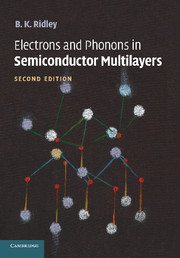Book contents
- Frontmatter
- Contents
- Preface
- Introduction
- 1 Simple Models of the Electron–Phonon Interaction
- 2 Quantum Confinement of Carriers
- 3 Quasi-Continuum Theory of Lattice Vibrations
- 4 Bulk Vibrational Modes in an Isotropic Continuum
- 5 Optical Modes in a Quantum Well
- 6 Superlattice Modes
- 7 Optical Modes in Various Structures
- 8 Electron–Optical Phonon Interaction in a Quantum Well
- 9 Other Scattering Mechanisms
- 10 Quantum Screening
- 11 The Electron Distribution Function
- 12 Spin Relaxation
- 13 Electrons and Phonons in the Wurtzite Lattice
- 14 Nitride Heterostructures
- 15 Terahertz Sources
- Appendix 1 The Polar-Optical Momentum-Relaxation Time in a 2D Degenerate Gas
- Appendix 2 Electron/Polar Optical Phonon Scattering Rates in a Spherical Cosine Band
- References
- Index
9 - Other Scattering Mechanisms
Published online by Cambridge University Press: 05 September 2009
- Frontmatter
- Contents
- Preface
- Introduction
- 1 Simple Models of the Electron–Phonon Interaction
- 2 Quantum Confinement of Carriers
- 3 Quasi-Continuum Theory of Lattice Vibrations
- 4 Bulk Vibrational Modes in an Isotropic Continuum
- 5 Optical Modes in a Quantum Well
- 6 Superlattice Modes
- 7 Optical Modes in Various Structures
- 8 Electron–Optical Phonon Interaction in a Quantum Well
- 9 Other Scattering Mechanisms
- 10 Quantum Screening
- 11 The Electron Distribution Function
- 12 Spin Relaxation
- 13 Electrons and Phonons in the Wurtzite Lattice
- 14 Nitride Heterostructures
- 15 Terahertz Sources
- Appendix 1 The Polar-Optical Momentum-Relaxation Time in a 2D Degenerate Gas
- Appendix 2 Electron/Polar Optical Phonon Scattering Rates in a Spherical Cosine Band
- References
- Index
Summary
I conceive some scattered notions…
An Argument against Abolishing Christianity, J. SwiftCharged-Impurity Scattering
Introduction
Scattering of electrons by charged-impurity atoms dominates the mobility at low temperatures in bulk material and is usually very significant at room temperature (Fig. 9.1). The technique of modulation doping in high-electron-mobility field-effect transistors (HEMTs) alleviates the effect of charged-impurity scattering but by no means eliminates it. It remains an important source of momentum relaxation (but not of energy relaxation because the collisions are essentially elastic). Though its importance has been recognized for a very long time, obtaining a reliable theoretical description has proved to be extremely difficult.
There are many problems. First of all there is the problem of the infinite range of the Coulomb potential surrounding a charge, which implies that an electron is scattered by a charged impurity however remote, leading to an infinite scattering cross-section for vanishingly small scattering angles. Intuitively, we would expect distant interactions with a population of charged impurities to time-average to zero, leaving only the less frequent, close collisions to determine the effective scattering rate. This intuition motivated the treatment by Conwell and Weisskopf (1950) in which the range of the Coulomb potential was limited to a radius equal to half the mean distance apart of the impurities. Setting an arbitrary limit of this sort was avoided by introducing the effect of screening by the population of mobile electrons as was done by Brooks and Herring (1951) for semiconductors, following the earlier approach by Mott (1936).
- Type
- Chapter
- Information
- Electrons and Phonons in Semiconductor Multilayers , pp. 217 - 243Publisher: Cambridge University PressPrint publication year: 2009



